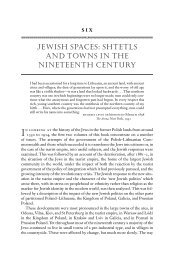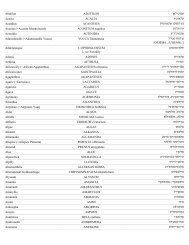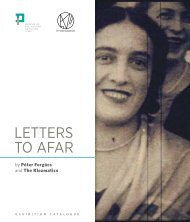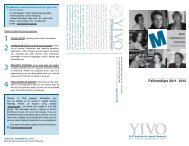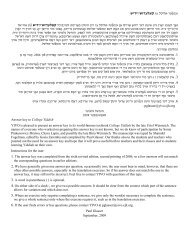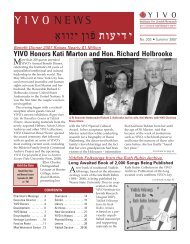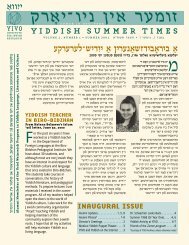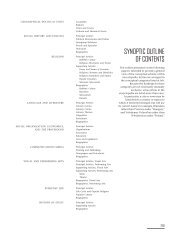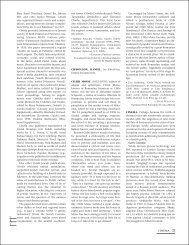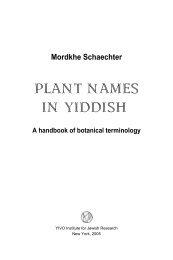geographical–political units - YIVO Institute for Jewish Research
geographical–political units - YIVO Institute for Jewish Research
geographical–political units - YIVO Institute for Jewish Research
You also want an ePaper? Increase the reach of your titles
YUMPU automatically turns print PDFs into web optimized ePapers that Google loves.
not subjected to the same severe purges as in the Soviet Union. Yiddish theaters were<br />
open, Yiddish books and newspapers were published with state subsidies, and <strong>Jewish</strong><br />
schools even operated in some cities. In Poland, the revitalization of Yiddish culture<br />
was carried out by committed <strong>Jewish</strong> Communists, such as Lili Berger, Dovid Sfard, and<br />
Hersh Smolar, who hoped that socialist Poland would recognize the immense suffering<br />
of the Jews and support their culture. Under Smolar’s editorship during the 1950s, the<br />
Warsaw newspaper Folks-shtime served as the main source of in<strong>for</strong>mation about <strong>Jewish</strong><br />
culture behind the Iron Curtain as well as a publishing outlet <strong>for</strong> Soviet Yiddish writers.<br />
The hopes <strong>for</strong> a revival of Yiddish culture in Poland were crushed by the antisemitic<br />
campaigns of 1968 that <strong>for</strong>ced the majority of remaining Jews, including most of the<br />
writers, to emigrate. In Romania, Yiddish cultural life revolved around the periodical<br />
almanac Bukareshter shriftn and the Yiddish theater in Bucharest.<br />
As a result of the political “thaw” and pressure from abroad, the new literary magazine<br />
Sovetish heymland was launched in Moscow in 1961, under the editorship of Arn Vergelis,<br />
who combined a good sense of Yiddish language with staunch adherence to the party<br />
line. The new magazine consolidated scattered survivors of the Stalin era and enabled<br />
them to return to creative work in Yiddish. But the aging audience was shrinking due<br />
to the absence of Yiddish education. In accordance with the general spirit of Soviet<br />
literature, Vergelis gave preference to texts that expressed optimistic views on Soviet<br />
life and did not dwell on tragedies of the past. Despite its ideological limitations, Sovetish<br />
heymland published a number of important works: novels by Der Nister, Tevye Gen,<br />
Shmuel Gordon, Note Lurye, Eli Shekhtman, and Nosn Zabara; short psychological prose<br />
and literary criticism of Rivke Rubin; critical and scholarly essays by Khayim Beider,<br />
Nokhem Oyslender, Leyzer Podriadchik, Arn Raskin, Hersh Remenik, Yisroel Serebriani,<br />
and Yankev Shternberg; and poetry by Rokhl Boymvol, Shike Driz, Motl Grubian, Yoysef<br />
Kerler, and Arn Vergelis. The magazine became increasingly politicized after the Israeli–<br />
Arab War of 1967, when the Soviet Union broke diplomatic relations with Israel and mass<br />
<strong>Jewish</strong> emigration from the Soviet Union began. Among the authors who left the country<br />
at that time were Boymvol, Kerler, Hirsh Osherovitsh, Podriadtshik, and Eli Shekhtman.<br />
After the demise of the Soviet Union, Sovetish heymland reinvented itself as the bilingual<br />
Russian–Yiddish magazine Di yidishe gas, which existed until 1996. The first issue of a new<br />
Yiddish small magazine, Der nayer fraynd, appeared in Saint Petersburg in 2004.<br />
—mikhail krutikov<br />
BIBLIOGRAPHY<br />
Gennady Estraikh, In Harness: Yiddish Writers’ Romance with Communism (Syracuse, N.Y., 2005).<br />
Ken Frieden, Classic Yiddish Fiction (Albany, N.Y., 1995).<br />
Mikhail Krutikov, Yiddish Fiction and the Crisis of Modernity, 1905–1914 (Stan<strong>for</strong>d, Calif., 2001).<br />
Sol Liptzin, A History of Yiddish Literature (Middle Village, N.Y., 1985).<br />
Dan Miron, A Traveler Disguised: The Rise of Modern Yiddish Fiction in the Nineteenth Century (Syracuse,<br />
N.Y., 1996).<br />
David Roskies, Against the Apocalypse: Responses to Catastrophe in Modern <strong>Jewish</strong> Culture (Cambridge,<br />
Mass., 1984).<br />
David Roskies, A Bridge of Longing: The Lost Art of Yiddish Storytelling (Cambridge, Mass., 1995).<br />
Ruth Wisse, I. L. Peretz and the Making of Modern <strong>Jewish</strong> Culture (Seattle, 1991).<br />
17



